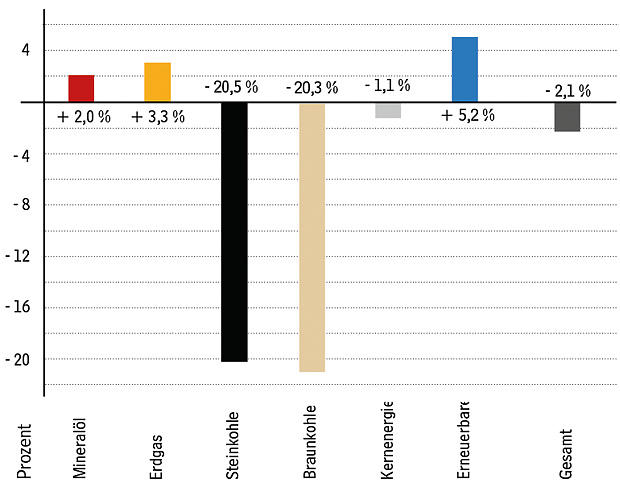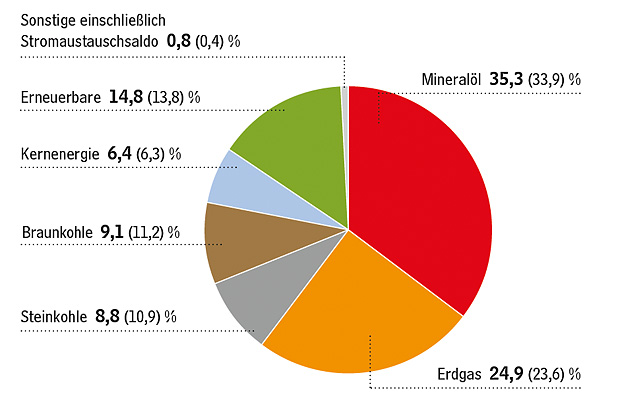
Fig. 1. Development of primary energy consumption in Germany in 2019 (changes in percent). // Bild 1. Entwicklung des Primärenergieverbrauchs in Deutschland 2019 (Veränderungen in Prozent). Source/Quelle: AGEB
Energy consumption in Germany fell to 12,832 PJ or 437.8 Mtce in 2019, 2.1 % below the level of the previous year (Figure 1). As the Working Group on Energy Balances, Berlin/Germany, states in its 2019 Annual Report, this reduction in consumption was due to additional improvements in energy efficiency, energy mix shifts and a decline in energy consumption in industry that occurred as a result of the economy. Factors in favour of increased consumption included the somewhat cooler weather conditions as well as the increase in population. However, the factors that reduced consumption had a much greater impact than those that increased consumption. According to calculations by the Working Group on Energy Balances, energy consumption would have decreased by 2.4 % if adjusted for the impact of the weather and changes in stock levels.
According to calculations by the Working Group on Energy Balances, overall economic energy productivity improved by 2.7 % in 2019 (3.1 % when temperature-adjusted). This parameter for the efficient use of energy is calculated from the energy input per unit of economic performance. The long-term average value of this parameter is 2.2 %. Overall, according to the conclusion reached by the Working Group on Energy Balances, the separation of economic development and energy consumption has thus continued to increase.
Developments in consumption and structural changes in the energy mix resulted in energy-related CO2 emissions in Germany decreasing by a significant 50 Mt in 2019. This is a decline of a good 7 % compared to the previous year.
In 2019, mineral oil consumption in Germany increased by a total of 2.0 % to 4,530 PJ (154.6 Mtce). Consumption of diesel fuel increased by 1.5 %; petrol consumption saw an increase of 0.7 %. Aviation fuel demand rose by 0.9 %. Sales of light heating oil rose particularly positively with an increase of 15.5 %. However, this development is due more to consumer stockpiling than to a real increase in consumption.
Natural gas consumption peaked at 3,191 PJ (108.9 Mtce) in 2019 and was therefore 3.3 % higher compared to the previous year. This development was influenced by the increased use of natural gas for electricity and heat generation in power stations and electricity suppliers’ combined heat and power (CHP) stations. The weather in the first half of 2019, which was, at times, significantly cooler than in the same period of the previous year, also led to an increase in sales, particularly to private households and the commercial, trade and services sector. A steady increase in the number of homes heated using natural gas intensified the increase in consumption. On the other hand, the economic slowdown led to a decline in the industrial demand for natural gas.
There was a sharp decline in the consumption of coal once again. Consumption fell by almost 21 % to 1,134 PJ (38.7 Mtce) compared to 2018. This downward trend, which has now been continuing steadily for six years, can be attributed in particular to, on the one hand, coal-fired power station capacities being taken off the market and, on the other hand, renewable energies being massively expanded in the electricity sector. The significantly higher price for CO2 emission certificates and low natural gas prices also contributed to this development. In the course of these developments, coal was increasingly replaced in power generation.
Lignite consumption peaked at 1,167 PJ (39.8 Mtce) in 2019. Consumption thus decreased for the seventh time in a row. The decline compared with the previous year was 20 %. Supplies to lignite-fired power stations also fell considerably due to the readiness for safety precautions at other power plant blocks, reduced handling in the Hambach surface mine, a higher number of power plant upgrades compared to the previous year, as well as an increase in electricity generation from renewable energies. Lignite remains one of the most important domestic energy sources with a total production of 131.3 Mt.
Nuclear energy recorded a slight decline of around 1 %. All told, nuclear energy still contributed a share of 820 PJ (28.0 Mtce) to the energy balance in 2019.
The total consumption of renewable energy sources in 2019 was 1,896 PJ (64.7 Mtce). This represents an overall increase of 5.2 % compared with the previous year. This was mainly due to a sharp increase in electricity generation and increased use of energy wood in private households and in the commercial, trade and service sectors. Wind power increased its contribution by 15 %. For hydropower there was an increase of 12 %. Solar energy only increased slightly by 2 %. Biomass, which accounts for more than 50 % of total volume in the area of renewable energies, recorded an increase of 2 %.
Renewable energy was able to expand its share in the energy mix for 2019 (Figure 2). Biomass, solar energy, wind energy, hydropower, geothermal energy and the biogenic share of waste accounted for a total of 14.8 % of the entire domestic energy consumption. The most important energy source was once again mineral oil, with a share of 35.3 %, followed by natural gas with 24.9 %. Coal accounted for a share of 8.8 % and lignite for 9.1 %. The contribution of nuclear energy accounted for 6.4 %.

Fig. 2. Structure of primary energy consumption in Germany in 2019 (Shares in percent/figures for previous year in brackets). // Bild 2. Struktur des Primärenergieverbrauchs in Deutschland 2019 (Anteile in Prozent/Vorjahreszeitraum in Klammern). Source/Quelle: AGEB
Domestic energy production recorded a decline of about 8 % to 3,582 PJ (122.2 Mtce) in 2019. German coal production ceased completely at the end of 2018 and thus no longer contributed to domestic energy generation in the year under review. Lignite recorded a decline of a good fifth. Domestic natural gas production (– 4 %) and crude oil production (– 7 %) also declined. In contrast, the renewable energies allocated to domestic energy sources recorded an increase of around 6 %. Overall, energy production from domestic resources was able to cover almost 30 % of total consumption. Today, the most important domestic energy source is renewable energy with a proportion of 53.2 % (previous year: 46.2 %). This is followed by lignite at 33.2 % (previous year: 38.7 %). The shares of other energy sources are in the low single-digit range. (AGEB/Si.)
